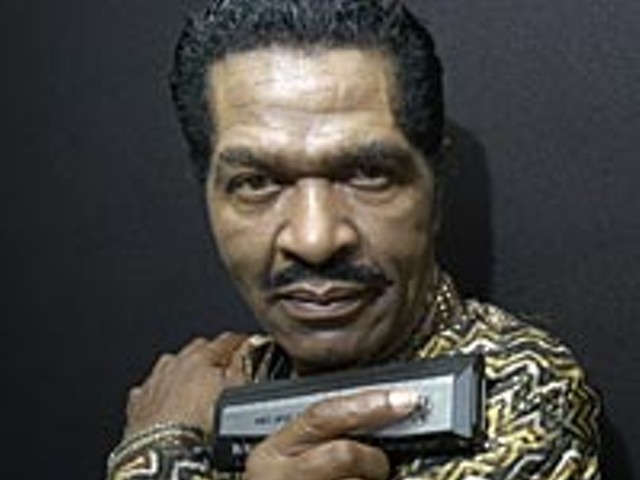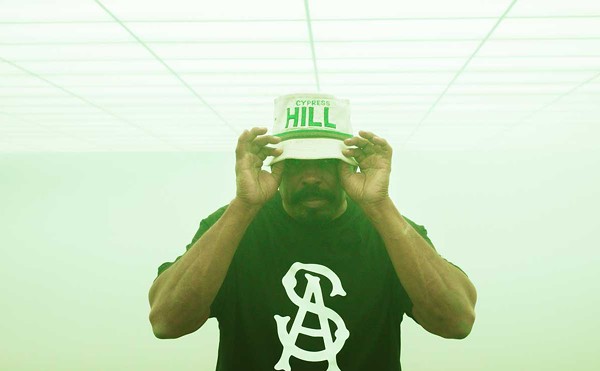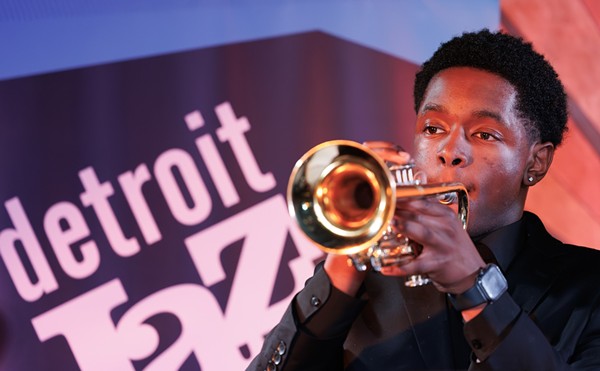T.S. Monk (born Thelonious Sphere Monk Jr.) is used to answering questions about his pop, bebop pianist/composer Thelonious Monk. The 54-year-old jazz drummer, vocalist, composer and record label owner began talking about his iconic dad in newspaper and magazine interviews decades ago. The questions often overshadowed the drummer’s own multifaceted career. Still, Monk Jr. has had chances to dispel misconceptions about his dad’s personality (that he was, among other things, reticent and withdrawn) and work ethic.
“Most of the stuff written about him is speculation,” T.S. explains during a recent phone interview. “How can you be withdrawn and be an entertainer and make an impact on other major entertainers? He spent his entire career extremely accessible. When he was on the cover of Time magazine you could look in the telephone book and get his home number.”
T.S. hasn’t reached his father’s recording output or stature, sure, but he has the same meticulous command of his instrument. He often attacks the drums with a youthful cockiness — boisterous episodes that leave the listener wondering if the percussionist should shield his face to prevent scorching from his explosive stickwork. Other times he’s simply graceful, making the drums sound as if they’re manufactured from cotton.
These days, T.S. lives in suburban New Jersey with his wife Gale and their two teenage children, Thelonious IV and Sierre. When he talks about being a musician, or when the subject swings to his father, he gets excited.
T.S. remembers scenes with his dad. “He would be hanging out with Miles Davis and the drummer Art Blakey around the house. I would be there hanging around doing my thing. My father would say something like: ‘Hey, Art, dig my son over there; he is automatically hip.’”
T.S. says Monk Sr. was diagnosed with bipolar disorder in 1964, and was one of the first anywhere to take lithium. The pianist continued to perform, regardless. Of course, his mental state caused some unusual behavior. Monk would pace endlessly, and twirl, nonstop in airports. He’d sometimes drift off into never-never-land. But T. S. says he can’t recall his dad ever missing a gig, or giving a subpar performance because of the illness. (He also says his father retired, not because he was mentally incapable of playing — as is often reported — but because he had had prostate surgery, which made prolonged periods of sitting and playing extremely uncomfortable.)
“Around the age of 12, my mother started explaining my father’s illness to me, and I learned that I had to look after him just as much as he looked out for us,” T.S. says. “So me, my mother and sister were absolutely dedicated to him.”
And, T.S. adds, Monk was always dedicated to them. “He had this unique way of building our self-esteem. He believed in us. He was glad that we were a part of him. He used to tell us that all the time.”
After Monk died in 1982, T.S. inherited his estate. In 2001, the son founded Thelonious Records to distribute previously unreleased music from his father’s archives, something Monk had wanted. The label has released seven of Monk’s live recordings from New York, Stockholm and Paris in the ’60s, and last year put out T.S.’s first album in four years, Higher Ground.
Thy own voice
As a youngster, T.S. was expected to play the piano. But he hated playing the piano. At 15, while attending boarding school in Connecticut, his roommate gave him a pair of drumsticks. He’d found his instrument.
“I recall watching Art Blakey and Max Roach and I understood everything that they were doing,” T.S. says. “Everything that the guys did looked to me like it was in slow motion. There was no mystery. I heard the sound and I understood how it was being made.”
To T.S.’s surprise, Dad encouraged the drumming and taught him to read music, taught him swing. Blakey presented the budding stickman with a drum kit; Roach gave him lessons.
“My father pointed me in the direction of some potential inspiration, and then it was on me to sink or swim. I think he did that because he knew the beating I would take if I lacked dedication. After that he never mentioned music to me again until I was 20 and he asked me to join his trio.”
This was T.S.’s first pro gig. He began touring with Pop in 1970. But the stint didn’t solidify his future.
“I worked with my father for the last years of his career, and then all of a sudden I discovered the real world of music,” he says. “I no longer had Dad’s gig. I was just another musician struggling in New York.”
The young Monk sought his own voice. After leaving his father’s trio, he made his bones as an R&B and fusion musician. As early as 1974, he drifted from jazz. He played with Paul Jeffrey’s Big Band, a percussion ensemble called Safari East, and a New England-based doo-wop group. He learned bandleader skills as a member of the fusion-y Natural Essence, a group he co-led from 1974 to 1978.
Soon after, he assembled the T.S. Monk Band, which included his sister Barbara “Boo Boo” Monk and his girlfriend Yvonne Fletcher, both vocalists. The band played many “Boogaloo” gigs at dancehalls. He shopped every label in New York for a record deal, but was ignored. And the critics attacked.
“The critics were saying, ‘How could Thelonious Monk’s son be playing R&B?’ They were talking like I was committing sacrilege. These were the same people that professed to love my father. If they remotely understood him they would have known exactly why I was doing R&B. The most disrespectful thing I could have done was try to emulate my father.”
The rejections continued to mount. Some band members became disgruntled, others fled. Monk Jr. began questioning himself. Then in 1979, Jerry Greenberg, chairman of Atlantic imprint Mirage, signed T.S. His first two albums, House of Music (which yielded the hit “Bon Bon Vie”) and More of the Good Life, shot up the R&B charts. Both albums, T.S. says, sold more than 250,000 copies. The drummer’s struggling appeared to be over. Then, two years later, tragedy struck.
Departure and the 800-pound gorilla
In February 1981, T.S.’s girlfriend Fletcher was diagnosed with breast cancer. She died that October. The following year, his sister Barbara died from cancer. He was crushed, but struggled to continue working. He recorded a pop album (Mere ’N Monk) that tanked. He put his drums away.
“Needless to say, my life turned around,” T.S. remembers. “Everybody expected me to keep chugging along. You know … I’m a team player, a team leader, but everybody was gone. So I just stopped everything. I stopped playing. I stopped writing. I got out of my record deal. I moved back home to Brooklyn.”
Before her death, Barbara had established the Thelonious Monk Foundation, for which T.S. assumed the administrative responsibilities. It grew into the Thelonious Monk Institute of Jazz, a nonprofit educational organization whose objective is to give the world’s most promising young musicians college-level training by jazz masters. T.S. eventually became the institute’s chairman.
In 1989, the board asked T.S. to participate in fund-raising performances with celebrity guests, such as trumpeter Wynton Marsalis and trombonist Slide Hampton. Though apprehensive, the drummer consented, and the move — after a six-year hiatus — rekindled his interest in performing.
Playing live inspired him to assemble a six-piece jazz band. He was gigging five months later. In 1992, T.S. returned to jazz full time and his first post-retirement recording was Take One, a hard bop album reminiscent of the Jazz Messengers. He was in his early 40s then, and didn’t really have a track record as a jazz musician. Once again, critics barked.
“They put the microscope on me when I was an R&B artist,” says T.S. “Now that I moved to jazz they pulled out the electron microscope.”
The reviewers were upset that he wasn’t playing his father’s music. T.S. felt he needed more practice before attempting Dad’s material.
“It took me years of really, really getting my shit together. In 1997, I felt it was time to deal with this 800-pound gorilla, which was my father’s music. Many people were making tribute albums. I wanted mine to be super-duper special.”
Before tackling his father’s legacy, T.S. did three LPs for Blue Note, Take One, Changing of the Guard, and The Charm. T.S. approached the albums with a rugged enthusiasm. He covered three of his father’s compositions (“Crepuscule with Nellie,” “Monk’s Dream,” and “’Round Midnight.”)
In 1997, he assembled a monster all-star band for a tribute album. Monk on Monk turned out to be the super-duper tribute he envisioned. Jazz journal Downbeat voted it Album Of The Year. It also received the New York Jazz Awards’ Recording of the Year.
In 1999, he drew on his R&B and fusion roots to make the well-received Crosstalk, and his latest, Higher Ground, is a confident and wonderful slab of hard bop, funk, soul and smooth improvisation.
As for his father’s legacy and Thelonious Records, T.S. plans to release more from Monk’s archives, his own music, and other cutting-edge jazz artists. He’s at a happy place in life, and the improvisation continues.
“Basically, this is my story and it has been totally ridiculous. Every one of these junctures that I have talked about was unplanned. I have been improvising as I go along. … That is what I am doing, improvising right up until this day.”
T.S. Monk will present “Monk on Monk Too” with a 10-piece band on Thursday, April 8, at Orchestra Hall in the Max M. Fisher Music Center (3711 Woodward Ave., Detroit). Call 313-576-5111 for info.
Charles L. Latimer writes about jazz for Metro Times. Send comments to [email protected]




